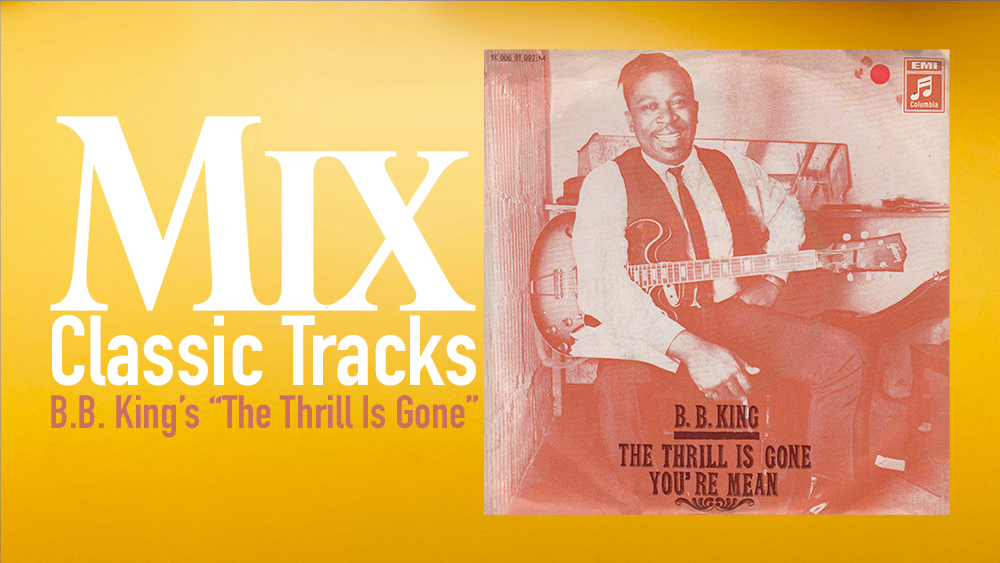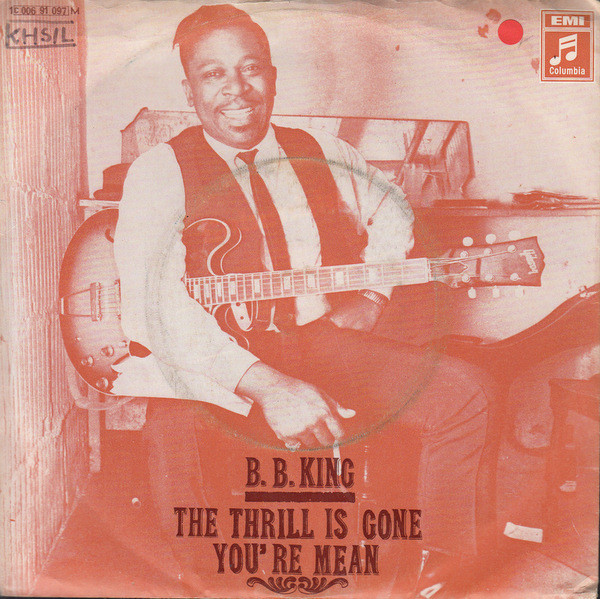
While much of what Bill Szymczyk has recorded during the past 40 years, from The Eagles to Joe Walsh to The Who, now forms the elevator soundtrack to our lives, one record in particular makes him smile when he hears it at the checkout counter in a mall. “I listen to B.B. singing ‘The Thrill Is Gone’ on the background music and notice people humming or singing along to it and I think to myself, ‘Little do you know.’”
In 1969, Szymczyk was just embarking on a career as a producer. After several years in New York City working as a staff engineer at Bob Lifton’s Regent Sound and then as chief engineer at Jerry Ragavoy’s Hit Factory, the former Navy sonar operator had gone freelance and built a thriving career as an independent audio engineer. But he was willing to take a substantial cut in pay to take on a gig as a staff producer at ABC Records to move his career path toward producing records.
Shortly after signing on, Szymczyk began a four-month lobbying campaign aimed at convincing label executives to let him make a record with B.B. King, whose label, BluesWay Records, happened to be a subsidiary of ABC. Reluctant at first to pair a white producer with a black blues artist, the A&R department relented on the condition that they could sell the idea to King himself.
By 1969, King had already enjoyed a 20-year recording career that included a number of R&B hits. Originally from Mississippi, where he worked as a sharecropper when he was young, Riley King moved to Memphis in the mid-’40s and learned much about blues guitar from his cousin, Bukka White. Later, King had a radio show in Memphis, and it was his DJ handle — “Beale Street Blues Boy” — that gave him his professional moniker: B.B. King. In 1949, he cut his first sides for Bullet Records and then switched to the RPM label, where Sam Phillips produced his first discs — pre-Sun Records. King’s first major hit was “Three O’Clock Blues” — cut in 1951 — the first of 18 songs King landed in the R&B Top 20. He didn’t fare as well on the charts once Motown started to push the blues to the side in the mid-’60s, though he remained a popular live attraction.
King’s records during the mid to late ’60s had been produced by Johnny Pate, using King’s road band. But once Szymczyk came into the picture, he envisioned a more polished, yet still kinetic, recording and, at an initial meeting at King’s hotel, pressed the guitarist to use certain New York session players — musicians he had met while working with Ragavoy. “The way it was, B.B. was basically recutting the same record over and over again,” Szymczyk says. “I outlined what I hoped to do. He said it was interesting, but he wanted to hedge his bet, so he said we won’t do the whole album that way, just half of it, the other half being done the way he always made records — with his band.”
The half-live and half-studio Live & Well came out in early 1969 and spawned the R&B chart hit “Why I Sing the Blues,” which also made a dent in the pop charts. This set the stage for Completely Well, containing “The Thrill Is Gone,” which would become King’s signature song, the franchise that he still rides strong 35 year later. Actually, the song had already been a hit once before for the song’s author, Roy Hawkins, back in 1951. Hawkins is largely forgotten today. The song was his last hit and he died in obscurity in 1973.
For the Completely Well sessions, Szymczyk repeated the formula that seemed to work well the first time around, recruiting an exceptional set of session players — Herbie Lovelle on drums, Gerald Jemmott on bass, Paul Harris on keyboards and Hugh McCracken on guitar. “It was an evenly mixed band racially — half black, half white — but they were all young guys,” Szymczyk recalls. “The energy was there. The black musicians had been doing serious R&B dates for Jerry Ragavoy and Tom Dowd over at Atlantic Records; the white guys were rock ‘n’ rollers, but they were steeped in the new awakening that America was having with the blues.”
On a September evening in 1969, Szymczyk, King and the musicians were at the studio in the original Hit Factory location at 701 Seventh Ave. Ragavoy had built another Hit Factory on West 48th Street between Eighth and Ninth Avenues and was in the process of closing the first studio down, making King’s record one of the last to be done there.
Szymczyk arranged the musicians around King, who sat with his back to a padded wall of the mid-sized (approximately 30×15-foot) recording room, with drummer Lovelle in a corner with low gobos around him, allowing eye contact with the rest of the band but providing some acoustical isolation. In the control room — behind the 12-input, custom-built, rotary fader — equipped console — Szymczyk sat with engineer Joe Zagarino, whom Szymczyk had trained at Regent Sound and who was now a staffer at Hit Factory. Behind them was a Scully 8-track deck. They listened through Altec 604E main monitors and KLH-17 near-field speakers. The guitar played through a Fender Twin Reverb miked with a Shure 57; the bass was a combination of direct and the redoubtable Ampeg B-15 in the room; and the piano was a Wurlitzer recorded with the same sort of signal split.
Like many hit records of an era of limited tracks, the magic was less technical than it was inspirational. “B.B. started playing the song riff in that minor key and Paul picked up on it immediately on the Wurlitzer electric piano,” Szymczyk remembers. “It fell into its groove in minutes. I was freaking out — that’s how good it was. The same musicians had played on ‘Why I Sing the Blues’ and they were pleased with how that had turned out, so the vibe was very up.”

King sang all his vocals live with the track. Szymczyk had placed a Neumann U67, set to cardioid, in front of him as close as possible without being uncomfortable. The amplifiers faced away and the rear wall had acoustical treatment. “This minimized leakage, but there was still plenty of it,” he says. “But what’s a little leakage when B.B. being out in the room singing was part of what made that record so cool?”
The song was rehearsed three or four times before the tape machine was lit up, and by the third recorded take, it was nailed. What sticks out in Szymczyk’s memory is how he let the band continue on with the outro vamp for what seemed like an eternity (actually about eight minutes; long for AM radio). “It was such a great groove,” he says. “Hypnotic and infectious and so damn cool. It was the last track of the last session of the album [which took a total of three days to record] and it was the perfect way to end it.” There were no overdubs, nothing to fix.
A week later, Szymczyk was several blocks away in the new Hit Factory studio on West 48th Street, again at a custom-built console but one with slide pot faders, a novelty at the time. He set up a pair each of U47 and U67 microphones over a 12-piece string section, recording them in stereo to the two available tracks of the original master recording. (The bass and drums had been recorded to two tracks simultaneously during the basic track session; the guitar, electric piano, King’s Gibson 355 “Lucille” and his vocal filled four other tracks.)
“I got the idea to put strings on it,” Szymczyk says. “I called B.B. the next day — in his memoirs, he says it was at 2 a.m. that same morning, but I can’t imagine myself doing that — and he hesitated a bit. But I called in a great arranger, Bert de Coteaux, who wrote this killer, hypnotic chart. Bert had done a lot of charts for Jerry Ragavoy that I had engineered over the years and he was big in the R&B circles. He came up with a great part that plays off the piano lick.
“The thing about the string part was I thought that this is what would put it over the top for the pop charts, make it palatable for a white mainstream audience. And it did. The thing I remember most vividly about that session was how B.B. smiled during it. This had never happened to him before — strings on a blues record. I’m not sure it had ever happened to anyone before. When you look at the big picture, this was the track that took him off the ‘chitlin’ circuit and put him in Vegas. I think he could hear that about to happen as we recorded the strings. No wonder he was smiling so big.”
The legato string lines pad the recording and do give it a pop effect that must have seemed radical at the time. Furthermore, de Coteaux’s sharper staccato notes on the vamp anticipate the string parts of the disco era, like those of Van McCoy, whom Szymczyk also listened to avidly in those days.
Szymczyk’s mix for “The Thrill Is Gone” and the rest of the album took place during just two days in the same new Hit Factory location. Effects were minimal: the studio’s two EMT plates. One plate’s decay was set at less than a second to create a small room effect; most of the tracks were put through that to varying degrees, including King’s vocals. The second plate was used for what Szymczyk calls “the old CBS [Studios] trick” — sending a signal to a “slap-back” effect tape delay and then passing it through the plate set for about a three-second decay, an effect used on the string tracks.
Mastering was done at Sterling Sound, engineered by that studio’s founder, Lee Hulko. “Lee used a Neumann lathe, which was pretty standard at the time,” recalls Szymczyk. “A little EQ and that was about it. No compression. This was before the ‘louder is better’ way of thinking about records.”
Szymczyk says the way “The Thrill Is Gone” came about was emblematic of a career he describes as blessed and serendipitous. “One thing always led to another,” he says. “But ‘The Thrill Is Gone’ was my first big hit; it became my calling card for the rest of my career. When the J. Geils Band hired me, it was because of that record. Believe me, the ‘thrill’ is still here.”
The song made it to Number 14 on the pop chart in the winter of 1970, astonishingly high for a blues record. The album made the Top 40 and stayed on the charts for 30 weeks. And ever since, B.B. King has been the undisputed King of the Blues.
This article was first posted on February 1, 2005.







